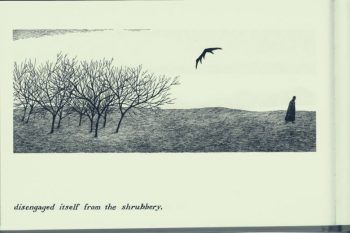Phil Baker at the TLS:
 With its somewhat whimsical skulls and bats, Gorey’s more accessible work has all the trimmings of Gothic Lite, part of the same cultural wave that has made H. P. Lovecraft’s Cthulhu into a popular plush toy. It tends to be set in a waveringly Victorian-Edwardian fin-de-siècle, or a louche and sometimes sinister vision of the 1920s. As Dery notes, Gorey’s retro negativity is partly “a code for signaling a conscientious objection to the present” and its crass positivity (its “Trumpian vulgarity”, as Dery calls it). Gorey’s friend Alison Lurie sees his fascination with funereal Victorianism as a reaction to the 1950s ethos according to which “everything was wonderful and we lived forever and the sun was shining”; and the Washington Post writer Henry Allen described him, in an obituary appreciation, as having “reached deeper into the educated American psyche” than Charles Addams, with whom he was sometimes paired: for Allen, he defied “the clamorous Doris Day optimism rampant at the start of his career”. Another of Gorey’s sharpest commentators, Thomas Garvey, writing in a context of Queer Theory, has suggested that Gorey’s ironic perversity “allows his art to be re-purposed by heterosexuals into a tonic for the pressures of wholesomeness”.
With its somewhat whimsical skulls and bats, Gorey’s more accessible work has all the trimmings of Gothic Lite, part of the same cultural wave that has made H. P. Lovecraft’s Cthulhu into a popular plush toy. It tends to be set in a waveringly Victorian-Edwardian fin-de-siècle, or a louche and sometimes sinister vision of the 1920s. As Dery notes, Gorey’s retro negativity is partly “a code for signaling a conscientious objection to the present” and its crass positivity (its “Trumpian vulgarity”, as Dery calls it). Gorey’s friend Alison Lurie sees his fascination with funereal Victorianism as a reaction to the 1950s ethos according to which “everything was wonderful and we lived forever and the sun was shining”; and the Washington Post writer Henry Allen described him, in an obituary appreciation, as having “reached deeper into the educated American psyche” than Charles Addams, with whom he was sometimes paired: for Allen, he defied “the clamorous Doris Day optimism rampant at the start of his career”. Another of Gorey’s sharpest commentators, Thomas Garvey, writing in a context of Queer Theory, has suggested that Gorey’s ironic perversity “allows his art to be re-purposed by heterosexuals into a tonic for the pressures of wholesomeness”.
more here.
